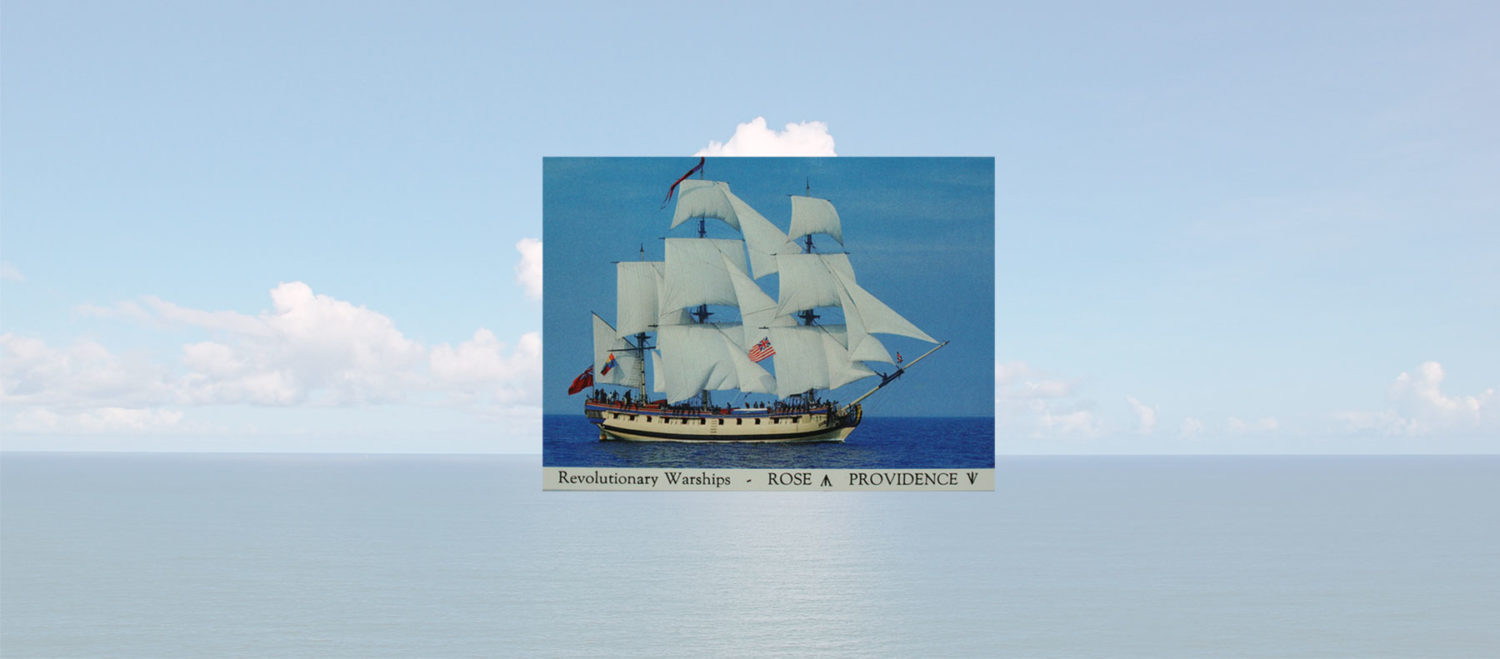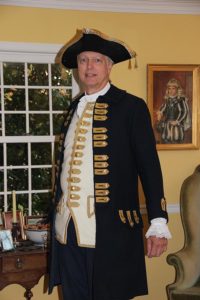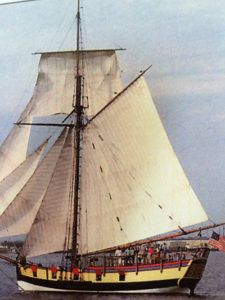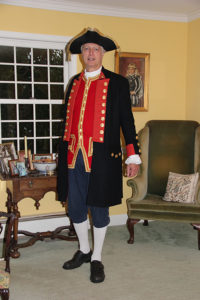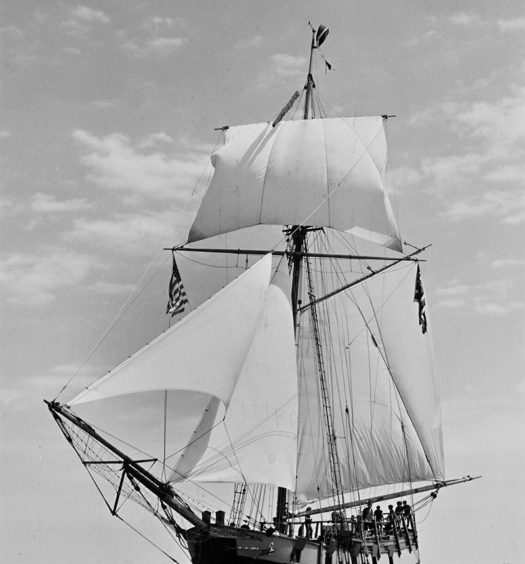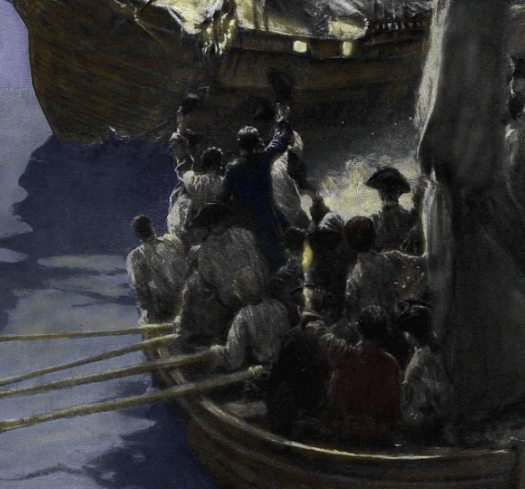Here is a brief account of the historical significance of the warships Rose and Providence during the Revolutionary War. Late in 1774, the British sent the 24-gun frigate Rose, under soon-to-be-hated Captain James Wallace, to patrol Narragansett Bay to try to enforce British tax and maritime laws that had never before been able to be enforced. Wallace did such a good job that the rum trade died, and large numbers of unemployed workers were forced to move to Connecticut in search of work. Once war broke out, Wallace torched houses on Jamestown, bombarded Bristol, and threatened to destroy Newport. As a result, the Rhode Island General Assembly petitioned Congress to establish a national navy in order to get rid of Rose. The Rhode Island-inspired bill passed in Congress on October 13, 1775, and written into the bill was a provision that the 12-gun sloop Providence should be the first ship of the American Navy. She was also the first to land the American Marines (March 1776) and the first command of John Paul Jones (May 1776). The original Rose departed Narragansett Bay in April 1776 and never actually fought any Continental Navy warships. By 1779, with her hull thoroughly rotten, she was sunk in order to block the channel of the Savannah River against a French invasion. By coincidence, the original Providence was destroyed by her crew to prevent capture, also in 1779, as part of the ill-fated Penobscot Bay expedition in Maine.
After I finished college in 1966, I bought and restored a 1704 house in the historic district of Newport, Rhode Island. I quickly realized that the American Revolution Bicentennial would be held in less than a decade. Because Newport was where the U.S. Navy had a long-standing presence, it seemed appropriate that Newport have some ships of that period on public display during the Bicentennial celebrations. However, only one ship existed from that period, the huge 100-gun British battleship Victory, which was permanently in a dry -dock in Portsmouth, England. That meant that if any such ships were to be displayed in Newport they would have to be reproductions, built from scratch.
I drew up a list of five ships that I thought would best tell the story, such as I knew it. Building reasonably accurate copies of them would not be a problem, in view of all the books already published on the subject and all the ships’ plans and models surviving in museums, such as the National Maritime Museum in Greenwich, just outside London.
Money could be a problem, because I essentially had none. I talked up the idea among friends, and they all thought it was a great idea, but when I asked them how much money they were prepared to contribute no money was offered. Then I remembered the story of 1930s bank-robber, Willy Sutton: a police officer had asked him why he was always robbing banks, and he replied, “Because that’s where the money is!” Therefore, I went to my bank and made an appointment with the loan officer in 1968.
I told him that I wanted to borrow enough money to build five Revolutionary War ships full-size for the Bicentennial. He threw his head back and roared with laughter. When he stopped laughing, he picked up the telephone and barked into it that the entire bank staff (except one teller) should come to his office, and when they crowded in he said, “Now you tell them what you just told me.” Predictably, they all roared with laughter when they heard my proposal.
I felt like two cents, but somehow I blurted out, “Do we have anything to talk about at all?” Suddenly the mood changed. The loan officer realized that he had been rude to a customer – and not just any customer. Although I did not know this at the time, it was my late grandfather who had founded that bank, and the loan officer knew that.
The loan officer asked me to choose one ship out of the five. I selected the 24-gun British frigate Rose, because she was the biggest. If you are going to have a ship museum, you need to have your ship big enough to persuade people to get out of their cars to come and look at it. “For that,” said the loan officer, “we could lend you $250,000.” I thought that was a fortune, but after checking with shipyards around the world I found that the frigate would normally be a $2 million ship (more like $15 million in 2016). Daunted, I almost gave up on the project.
One of the shipyards I had consulted was the venerable Smith & Rhuland, Limited in Lunenburg, Nova Scotia, Canada. They had previously built the famous fishing schooner Bluenose that appears on the Canadian dime, and the MGM Films Bounty, as well as modern copy of the Bluenose. Fred Rhuland telephoned and told me that he thought he could do better, because he really needed the work to keep his workers going. “You won’t be needing engines, generators, gearboxes, propellers, or life-support systems, and those are the expensive parts of a ship. If you pay separately for the ropes, the sails, and the cannons, we can build the ship for $250,000,” said Fred. “Done!” I replied, and went back to the bank to claim the money.
The bank was surprised to see me, but it had made a commitment and I was prepared to meet its terms, so it was obliged to lend the money. Incidentally, banks today always require detailed business plans before lending money, and business plans were also part of the picture in the colonial period. However, for some reason none was required at this time.
I got in touch with the Samson Braid company to see if they would donate enough rope for the ship’s running rigging, thinking that if the ship sailed only occasionally the braided rope would be easier on the crew’s hands than regular rope. The company generously and cheerfully donated five miles of rope. The famous Hood Sailmakers of Marblehead, Massachusetts, who had made sails for America’s Cup yachts, similarly contributed at greatly reduced cost the 13,000 square feet of sails. The cannons I bought out of petty cash, most from a firm called Barney’s Cannons in South Bend, Indiana (since renamed South Bend Replicas).
The National Maritime Museum in Greenwich was able to supply photocopies of the frigate’s original plans, but eighteenth-century plans do not offer all the information required by modern shipyards, or, for that matter, by the U.S. Coast Guard. Therefore, I needed the services of a naval architect. Based on some of his graceful yacht designs, I picked Philip Bolger of Gloucester, Massachusetts. Bolger seemed to like the challenge presented and went to work on the plans. I had to ask him to change the heights of the various decks, because the bank required sufficient headroom so that if they had to foreclose they could always sell the ship to someone who wanted a waterfront restaurant. Bolger did make a few changes to the underwater lines as well without authorization “to make her a little faster,” he later told me. On our first meeting, I asked Bolger if it would make sense to use the new technology of building the ship out of thin pieces of wood laminated with epoxy – “cold-molded.” He replied that the technology was so new that no one could predict its life-span or any potential problems. Had we used that technology, the ship might never have suffered from rot years later; traditional wooden ships typically had a life-span of only fifteen years.
Smith & Rhuland held a keel-laying ceremony in June 1969, using two enormous pieces of Douglas fir from the West Coast. The rest of the wood for the sawn frames and the 3 and 4-inch planking came from hardwood trees grown within a few miles of Lunenburg, white oak, red oak, beech, and birch. The inner planking, as did some of the spars, came from black spruce growing within a few miles of Lunenburg. Deck planking and some other spars came from West Coast Douglas fir. At the request of the shipyard, the fore and main lower masts were made of steel. Rum was the favored drink among Nova Scotia shipyard workers, and years later we found many empty rum bottles abandoned in remote areas of the ship’s structure.
Construction moved fast, and the ship was ready for launching in March 1970. The launching was done by Ruth Alofsin, the wife of the mayor of Newport, Fred Alofsin. Even though the shipyard would step all the masts, I was informed that it was my job to install the rigging, so two friends from Newport (who got married in Lunenburg while we were there), and my British girlfriend, and I did all the rigging over the next few weeks. The shipyard hired a famous captain to take the ship out for a sail to prove that everything worked the way it was supposed to, but I had to miss the event because the bank insisted that I return to Newport at that moment to make a report.
Meanwhile, other things in Newport began to fall apart. I had made an agreement with a local hotel then under construction that the ship could be moored at its pier, but the hotel’s construction was seriously delayed so the ship was not welcome to use the pier in the meantime. At the same time, I had arranged for insurance coverage by Lloyds, but suddenly they backed out with no explanation. Luckily, I was able to get coverage from the American firm MOAC, provided that its lead underwriter, Chip Hoins, would sail with us on the voyage from Lunenburg to Newport. He turned out to be a useful member of the crew.
Then the Canadian government announced that under Canadian law no unregistered ship over a certain size may sail in Canadian waters; at the same time, the US government told us that if we were registered we would not be allowed to be a floating museum and charge admission. The obvious answer was to have a Canadian fishing boat tow us out of Canadian waters (a towed vessel never needs to be registered), but Canadian bureaucracy refused to budge until I got on the telephone, put on a thick British accent, and blusteringly ordered the ship released. She was released instantly. What if the official had been a Francophone?
After a quick visit to Boston, we began to be towed by a tugboat through the Cape Cod Canal to the entrance of Narragansett Bay, where we sailed into Newport to the approval of large crowds gathered along the shore. Impressed by the ship, then Lieutenant-Governor J. Joseph Garrahy made me one of the founding members of the Rhode Island Bicentennial Commission, the youngest member. At the first meeting, I proposed that since Bicentennial projects could not expect any state or federal money we should invite the Bicentennial Commissions of the other original states to join us in a super organization that could raise money for us; the resulting Bicentennial Council of the Thirteen Original States raised millions for Bicentennial projects in the thirteen states until it was put out of business in 1991.
The hotel pier being not available to us, we stayed a short while at Newport Shipyard until we received an offer to moor the ship at historic Bowen’s Wharf. Bowen’s Wharf was then too shallow, thanks to years of silting, so we requested the tugboat to blast out the silt with its propeller. Rose looked completely at home at Bowen’s Wharf, but the surface of the wharf was covered in a thick layer of coal dust, which quickly got tracked all over the decks of the frigate. When Bowen’s Wharf declined to remove the coal dust, we had no choice but to take the ship to another pier at Goat Island. That brought a law-suit from Bowen’s Wharf, which entitled Bowen’s Wharf to take any admissions money collected at Goat Island, even though no court judgement had yet been entered, so the frigate did not charge admission at all for the rest of the summer.
The following summer, 1971, since the lawsuit was not withdrawn, the only way for the ship to earn money from the $1 admission charge was to take her to another state, so we sailed her to historic Long Wharf in Boston. The officials there could not have been nicer in providing all the amenities we needed. As a favor to the community, I organized sea chantey concerts aboard the ship every Friday evening, and these concerts were soon the place to go for all folk music enthusiasts in Boston. One such enthusiast was a young nurse, who enjoyed the concerts so much that she arranged her schedule so that she could attend every week. A year later, Cathy Obst and I were married in Newport.
In the summer of 1972, since the lawsuit was now settled, we sought permission from city officials to have the ship open to the public next to the causeway to Goat Island. That summer, the ship was hired for two motion pictures. In the first, a commercial for Sears paint, she played the part of John Paul Jones’s ship Ranger, sailing down Narragansett Bay as a lead-in to the fact that Sears had provided the paint for John Paul Jones’s house in Portsmouth, New Hampshire; the part of Jones was played by Kim Granbury. The second film, The Man Without a Country, was a made-for-television production, starring Cliff Robertson (who had to hide the fact that he had a broken leg at the time) and Beau Bridges. Rosemont Productions could not find the money necessary to take the ship out sailing, so the entire film was shot with sails set as she was securely moored to the pier.
In the summer of 1973, my financial advisor Jack Martin kindly had a word with a friend of his who owned a marina called The Mooring, just south of Banister’s Wharf, so Rose began a seven-year stay in that location. The harbor there was shallower than we wanted, and there were occasions when the ship sat on the bottom at low tide and leaned over at an alarming angle. This predictably started rumors that she was about to sink. We took her out for a sail nearly every year, even though that was expensive in terms of having a tug-boat in attendance each time and of an additional insurance premium.
With the Rose now in a stable situation, I decided that the time had come to proceed with further ships. I therefore established a non-profit, tax-exempt corporation, Seaport ’76 Foundation, Ltd., whose purpose was to take over Rose from me at cost, and proceed to build the rest of the ships. I invited mostly retired US Navy officers and US Marine Corps officers to serve on the board, and they elected a rear admiral as president. The admiral called a meeting of the board to interview a fund-raiser. The fund-raiser told us that the first meeting was free, and then he gave us some advice. First, he said, even though he was called a fund-raiser, he did not actually raise funds. He would show us how to raise funds, after having first taken a hefty fee from us. Then he said, “There are three ‘Gs’ in being on a board like this one: 1) you need to be able to GIVE lots of money; 2) you need to be able to GET other people to give lots of money; 3) if you can’t do either of those two things, you ought to GET off the board.” We thanked him for his time, and decided to proceed on our own without him.
In which direction should we go? Obviously, taking over the Rose could take a back seat. We needed to build a new ship, and the one most suited for the Bicentennial was the 12-gun Continental Navy sloop Providence. The original vessel had been the first ship authorized for the Continental Navy in October 1775, the first to land the American Marines, and the first command of John Paul Jones. I proposed that we ask Smith & Rhuland to bid on constructing the sloop, but all the retired naval officers were appalled at the notion that the reproduction of the American Navy’s first ship should be built in Canada. She would have to be built in Rhode Island, they declared, no matter what the cost, so she was actually built in an unused facility on the U.S. Navy Base at Newport, and the board hired workmen to accomplish the task over two years.
I had estimated that the price of having her built in Canada would come to about $150,000, but having her built at Newport actually cost just over $1.5 million. Nevertheless, we managed to raise that sum. The board decided to emphasize longevity by constructing her of heavy-gauge fiberglass, something that took two years to complete from 1974 to 1976. I located three eye-witness period illustrations of the sloop, so we know what she looked like, and we also consulted some rather inaccurate twentieth-century models.
As the project was getting under way, one of the retired captains asked the designated naval architect, Charles Wittholz, to make changes to the plans, without clearing the idea with the board. John Paul Jones’s first command was fast, he said; could you make her sharper? While you’re at it, we would like to be able to move the sloop around on the East Coast’s Inland Waterway, which has a controlling depth of eight feet, so, could you make her shallower? Although the board had not voted to make these changes, Wittholz made them. Months later, and only a few weeks before the sloop was to be launched, Wittholz telephoned me in great consternation. Now that he had made the changes, he said, the new stability calculations showed that the sloop would not pass US Coast Guard standards, and so would not be permitted to carry people for hire; what did I recommend? I recommended that we cut down the size of the sails, and add a much deeper lead keel. She then met the Coast Guard standards, but would never be able to navigate much of the Inland Waterway.
The board then told me that they never had any intention of exhibiting the sloop in conjunction with Rose, nor was there any chance that they would ever take over the frigate. They no longer wanted to build any additional ships. They were having fun, they said, sailing the sloop, and she was never going to be expensive to insure, maintain, and repair, whereas the frigate was dauntingly expensive to insure, maintain, and repair. Of course, I was not in a position to face those bills either, so I made plans to sell the ship. I headed off to graduate school at the College of William & Mary in Virginia in 1980, and the ship took until 1984 to sell – at a pittance – to a group led by Kaye Williams in Bridgeport, Connecticut, who merely wanted her to decorate their marina there. The bank loan was of course paid off first.
Two weeks after I sold her, Congress changed the rules under which ships like her could operate. Suddenly, she was permitted to carry people for hire, which I was not permitted to do – not passengers, but sail-trainees. What is the difference? Sometimes very difficult to tell. Richard Bailey, who had served me a few years as captain, presented himself in Bridgeport and strongly urged Williams to change his plans and rebuild the ship so as to comply with all the new Coast Guard regulations for sailing school vessels. Williams borrowed some money and got grants from the state, and spent about $2 million overhauling the ship, including installing engines. She had her grand coming-out at the Operation Sail in New York City that celebrated the 100th birthday of the Statue of Liberty in 1985. Kaye Williams placed much of the daily strategy of running the ship in the capable hands of his daughter Jan.
Richard Bailey was the ship’s dedicated captain, and he competently operated the ship for the next sixteen years with thirty-one paying trainees at a time on generally one-week cruises along the East Coast (often visiting Rhode Island), sometimes into the Great Lakes or Hudson’s Bay, and sometimes along the Gulf Coast or through the Caribbean, and one glorious summer of 1996 in Europe for a series of Tall Ships events in celebration of the 500th anniversary of Cabot’s first voyage to Newfoundland. While she was in France, she visited the historic port of Rochefort. The mayor there had been racking his brains, trying to think of something different that Rochefort could do in order to put the city on the tourist map. If somebody else can build a ship like that, he reasoned, so can Rochefort. Accordingly, Mayor Jean-Louis Frot began a program to build a slightly larger frigate from 1779, L’Hermione, whose claim to fame was that she brought Lafayette over to Boston to fight for our independence in 1780. 250 years ago, ships like that took about nine months to build, but Mayor Frot carefully spun it out to seventeen years, and most of the roughly $30 million cost was covered by charging admission to the shipyard. L’Hermione (pronounced LAIR-ME-UNN), Rose’s god-daughter as it were, made a well-publicized tour of East Coast ports from Yorktown, Virginia to Lunenburg, Nova Scotia, with one of her stops in Newport, during the summer of 2015, but she has never met the Rose and never will.
Late in the 1990s, the publisher W. W. Norton & Company rented the Rose at pier-side in New York for a party to celebrate the publication of the latest Patrick O’Brian novel in the Jack Aubrey series about ships in the Napoleonic Wars. O’Brian himself was present, and he casually mentioned to Bailey that if Rose were to be painted in an 1805 color scheme she would be a dead-ringer for the frigate Surprise that appeared in several of his books. Bailey quickly ordered the crew to get out the paint and make the changes. O’Brian was so impressed that he changed his mind about his previous prohibition against having any of his books converted into film. Norton immediately started looking for the right Hollywood production company.
Rose had a last hurrah on the East Coast by being the star at Operation Sail in New York in the year 2000; the event coincided with the birth of Bailey’s daughter Elinore, so all during Operation Sail the frigate had the signal flags flying, “It’s a girl.” That fall, Williams, who was tired of waking up in the middle of the night wondering if the ship was weathering a storm, decided to sell the ship, so Bailey quickly arranged that a non-profit group in Rhode Island should buy her. The sales agreement was signed.
The actual transaction was to take place on a Tuesday, but on the Saturday before the date, a man showed up in Bridgeport representing Twentieth-Century Fox, and insisting that Fox wanted to buy the ship. When he was told that the ethical way was to discuss matters with the group in Rhode Island, he explained that he was empowered to offer three times as much money as the Rhode Island group was paying. At that point, Williams gave in, but made Fox sign an agreement to donate the ship to the Rhode Island group as soon as they were finished with filming on the ship. The frigate departed Newport under sail in January 2003. She encountered storm winds in excess of 100mph before motoring through the Panama Canal.
The film in question was to be Master and Commander: The Far Side of the World, starring Russell Crowe. Peter Weir, the director, took great pains to make sure every detail was accurate, so the film opened to great critical acclaim. When Fox, which is based in San Diego, had clearly finished with the ship, people in Rhode Island quietly asked when they could expect the ship to be handed over to them. They were told, in effect, “We had our fingers crossed when we signed that agreement. If you want to sue us, we have a lot more lawyers than you have.” So, Rose (now renamed Surprise) is being well maintained, and is open to the public at the Maritime Museum of San Diego. She even goes sailing a few times a year. Rose starred, ironically under the name of Providence, in Pirates of the Caribbean IV, and in a Super Bowl commercial for TurboTax.
The Rhode Island group acquired a Canadian-built steel hull slightly bigger than the Rose, and at vast expense she has been transformed into the new sail-training ship Oliver Hazard Perry. The new ship is expected to continue a sail-training program where Rose left off. Shortly after the O’Brian movie was made, both Kaye and Jan Williams had died.
As for the sloop Providence, she turned out to be less capable of earning money than the board had thought, and by 1995 the corporation was bankrupt. The mayor of Providence, Vincent “call-me-Buddy” Cianci, heard that the sloop was about to be sold to West Coast interests, so he raised some money and talked the creditors into donating their interests to the city of Providence. For several years, she took high school students on short sails around Providence Harbor. However, Cianci was later sentenced to several years in the Federal Penitentiary. His successor as mayor felt that he could not justify public expenditures for the sloop, so he arranged to sell her. The buyer was a well-respected charter-boat captain, Thorpe Leeson, and he used her to take passengers out of Newport for sails lasting a few hours each day. Leeson also chartered the sloop to Disney in order to have her star in Pirates of the Caribbean V, to be released in 2016.
In February 2015, Providence was sitting, fully-rigged, in her cradle on land at Newport Shipyard, when a blizzard with peak winds of 105 miles per hour hit Newport. The sloop was knocked over, with a large hole punched in her bottom and all her spars shattered. She is now for sale. (If you can please make a donation to help to repair the Providence in the link next to this article.)
[Banner Image: The replica of the Royal Navy frigate HMS Rose (John Millar)]
